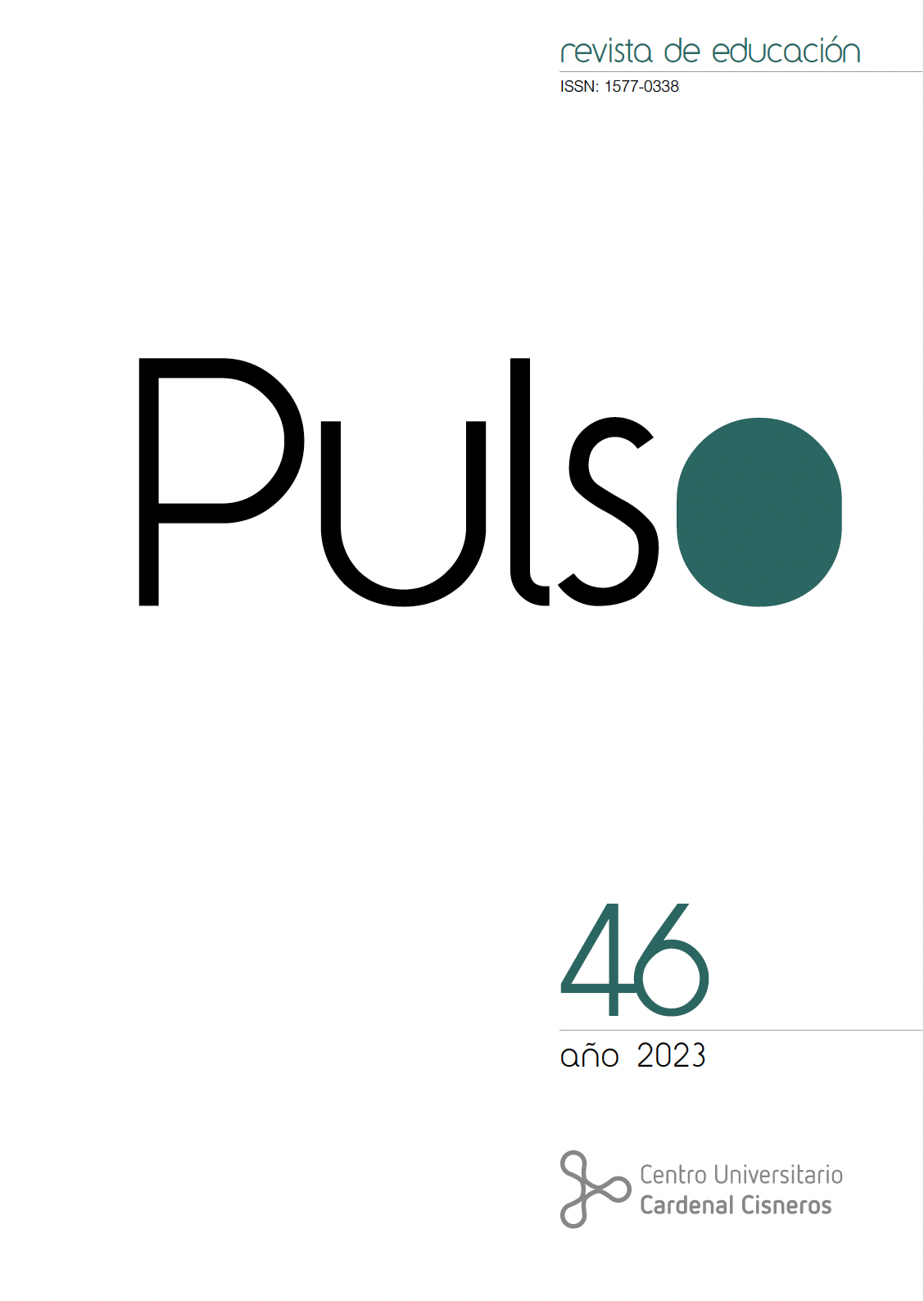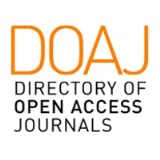Tangencies between art and science in teacher training: interdisciplinary experiences in the primary school degree course
DOI:
https://doi.org/10.58265/pulso.5934Keywords:
STEAM, Science education, Arts education, Initial teacher trainingAbstract
The interdisciplinary project carried out by the areas of visual art and physics and chemistry pedagogy has managed to position itself as an exemplary model of teaching innovation at the University of Zaragoza. This article materialises one of the project’s areas of research, in which contemporary works of art are used as the starting point for the development of proposals related to mechanical machines. The aim of this study is to define, implement and analyse learning from an interdisciplinary point of view under the STEAM approach for the training of future primary school teachers. Some of the most notable results are presented, all of them centred on the three-dimensional products through which the integration of artistic and scientific knowledge was studied. Finally, conclusions are reached in which we note that interdisciplinarity is one of the present and future ways to meet the educational needs that arise in the complexity of current times.
Downloads
References
Ander-Egg, E. (1999). El taller: una alternativa de renovación pedagógica. Magisterio del Río de la Plata.
Augsburg, T. (2005). Becoming interdisciplinary: An introduction to interdisciplinary studies. Kendall/Hunt.
Bandura, A. (1997). Ejercicio de la eficacia personal y colectiva en sociedades cambiantes. En A. Bandura (Coord). Autoeficacia: Cómo afrontamos los cambios de la sociedad actual. Desclée de Brouver.
Bransford, J., Darling-Hammond, L. & LePage,P. (2005). Introduction. En L. Darling-Hammond&J.
Bransford (Ed.s), Preparing Teachers for a Changing World: What Teachers Should Learn and Be Able to do (1 Ed., pp. 1-39). Jossey-Bass.
Boix-Mansilla, V & Dawes, E. (2007). Target assessment of students’ interdisciplinry work: An empirically grounded framework proposed. The Journal of Higher Education, 78(2), 215-237 doi:10.1353/ jhe.2007.0008.
Borsay, K. D. & Foss, P. (2016). Third Graders Explore Sound Concepts through Online Research Compared to Making Musical Instruments. Journal of STEM Arts, Crafts, and Constructions,1(1), 46-61. https://cutt.ly/egd8wZ3
Borroy, J. (2013). El magisterio como agente de innovación pedagógica. Educar, 51(2), 239-258.
Cabero, J. (2001). Tecnología Educativa. Diseño y utilización de medios en la enseñanza. Paidós.
Caeiro Rodríguez, M. (2019). Recreando la taxonomía de bloom para niños artistas. Hacia una educación artística metacognitiva, metaemotiva y metaafectiva. Artseduca, (24), 65-84.
Catalá, J.M. (2005). La imagen compleja: La fenomenología de las imágenes en la era de la cultura visual. UAB.
Cline, J. E., y Smith, B. A. (2016). Water Play. Journal of STEM Arts, Crafts, and Constructions, 1(2), 6-22. https://eric. ed.gov/?id=EJ1151177
Davies., M. y Davlin, M. (2007). Interdisciplinary higher education: Implications for teaching and learning. Centre for the Study of Higher Education.
De Echave, A., Ferrer-Bueno., L.M. & Morales, M.J. (2011). La relevancia y el valor de los trabajos prácticos en Educación Primaria y en la formación del profesorado de este nivel: Una experiencia de Aula. Investigación en la escuela, 74, 101-112
Delors, J. (1996). La educación encierra un tesoro. UNESCO
De Puig, I. (2004). Pensar, percibir, sentir y pensar. Octaedro.
Eger, J. (2015, November 24). The Congressional STEAM Caucus may turn STEM to STEAM in the reauthorization of ESEA. Retrieved from www.huffingtonpost.com/john-m-eger/stem-may-become-steamoffi_b_8634126.html
Eisner, E.W. (2004). El arte y la creación de la mente. El papel de las artes visuales en la transformación e l aonciencia. Paidos Ibérica.
English, M. C., & Kitsantas, A. (2013). Supporting Student Self Regulated Learning in Problem and Project-Based Learning. Interdisciplinary Journal of Problem-based Learning,7(2),128-150
Fernández-Pérez, M. (1994). Así enseña nuestra universidad. Universidad Complutense de Madrid.
Fiallo, J. (1996). Las relaciones intermaterias: una vía para incrementar la calidad en la educación. Editorial Pueblo y Educación
Fosnot, C. T. (1996). Constructivism: A psychological theory of learning. En C. T. Fosnot (Ed.), Constructivism: Theory, perspectives, and practice (pp. 8-33). Teachers College Press.
Foucault, M. (2003). Vigilar y castigar. Nacimiento de la prisión. Siglo XXI
Gates, A. E. (2017). Benefits of a STEAM Collaboration in Newark, New Jersey: Volcano Simulation Through a GlassMaking Experience. Journal of Geoscience Education, 65(1), 4–11. https//doi.org/10.5408/16-188.1
Gell, A. (1998). Art and agency. An anthropological theory. Clarendon Press.
Goodman, N. (1990). Maneras de hacer mundos. Visor.
Gurnon, D., Voss-Andreae, J., & Stanley, J. (2013). Integrating art and science in un-dergraduate education. PLoS Biol, 11(2), https://doi.org/10.1371/journal.pbio.1001491
Hillman, S., Bottomley, D., Raisner, J., & Malin, B. (2000). Learning to practice what we teach: Integrating elementary education methods courses. Action in Teacher Education, 22(2), 1–9
Hodson, D. (1994). Hacia un enfoque más crítico del trabajo de laboratorio. Enseñanza de las Ciencias, 12(3), pp. 299-313
Holley, K. A. (2009). Special issue: Understanding interdisciplinary challenges and opportunities in higher education. ASHE Higher Education Report, 35(2), 1-131.
Klein, (1990). Interdisciplinarity: History, theory, and practice. Wayne State University Press.
Klein, J.T. (1993). Blurring, cracking, and crossing: Permeation and the fracturing of discipline. En E. Messer-Davidow, D.R. Shumway, & D.J. Sylvan, (Eds.). Knowledges: Historical and cultural studies in disciplinarity (pp. 185-211). University Press of Virginia.
Liao, C. (2016). From Interdisciplinary to Transdisciplinary: An Arts-Integrated Approach to STEAM
Education, Art Education, 69:6, 44-49, DOI: 10.1080/00043125.2016.1224873
Lenoir, Y. (2015). Interdisciplinariedad en educación: una síntesis de sus especificidades y actualización. INTER DISCIPLINA, 1(1). https://doi.org/10.22201/ceiich.24485705e.2013.1.46514
León, G. (2010). La formación interdisciplinaria de los profesores: una necesidad del proceso de enseñanza y aprendizaje de las ciencias. Ensayos Pedagógicos (5),1
Loughran, J., & Berry, A. (2005). Modeling by Teacher Educators. Teaching & Teacher Education, 21, 193-203. http://dx.doi.org/10.1016/j.tate.2004.12.005
Lunenberg, M., Korthagen, F., Swennen, A. (2007). The teacher educator as a role model. Teaching and Teacher Education, 23, 5, pp. 586-601.
Maurer, R. E. (1994). Designing interdisciplinary curriculum in middle, junior high, and high schools. Needham Heights, MA: Allyn and Bacon.
Morín, E. (2007). Complexité restreinte, complexité générale, en Intelligence de la complexité. Épistémologie et pragmatique. Éditions de l’Aube: 28-64.
Murillo-Ligorred, V., Serón Torrecilla, F. J. & Revilla, A. (2020). Arte y ciencia en la formación de maestros: una propuesta interdisciplinar de aprendizaje de la luz y el color a través de la obra de Ignacio Fortún, AACA Digital, nº50.
Murillo-Ligorred, V. & Ramos-Vallecillo, N. (2023). Museo, industrias culturales y patrimonio. Entrevista con Karin Ohlenschläger, directora de LABoral Gijón. Noviembre de 2020, Arte, Individuo y Sociedad 35(1), pp. 303-333
Newell, W.H. (2001). A theory of interdisciplinary studies. Issues in Integrative Studies, 19, 1-25.
Nicolescu, B. (1997). The transdisciplinary Evolution of the University Condition for Sustainable Development. Bulletin Interactif du Centre International de Recherches et Études transdisciplinaires n° 12
Nicolescu, B. (2002). The unfathomable pornography of binary thinking. En B.Nicolescu & J. Visser, Eds., L’Apprentissage dans le creuset/Learning in the crucible. Special issue of Rencontres Transdisciplinaires, 16, February, 36-38
Perera, F. (2008). Proceso de enseñanza-aprendiaje. Interdisciplinariedad o integración. Varona 48-49/2009 43-39
Perrenoud, Ph. (2004). Desarrollar la práctica reflexiva en el oficio de enseñar. Profesionalización y
razón pedagógica. Graó
Pombo, O. (2013). Epistemología de la interdisciplinariedad. La construcción de un nuevo modelo de comprensión. Interdisciplina I, núm 1 21-50.
Ramos-Vallecillo, N. (2020). Aplicación de Design Thinking para la sistematización de procesos artísticos en el alumnado de Secundaria, Revista de Investigación en Educación, 18(1), 24-39, https://doi.org/10.35869/reined.v18i1.2628
Rampley, M. (2005). Art history and cultural difference: Alfred Gell’s anthropology of art. Art History. https://doi.org/10.1111/j.1467-8365.2005.00475.x
Schopenhauer, A. (2004). El mundo como voluntad y representación, vol. 1, edición y traducción de Roberto R. Aramayo (Madrid: Fondo de Cultura Económica, p. 144
Serón, F.J. (2015). El aprendizaje basado en proyectos Arte, Ciencia, Tecnología y Sociedad en el bachillerato artístico. Una Metodología para el aprendizaje de contenidos científicos. Tesis doctoral. Universidad de Zaragoza.
Serón Torrecilla, F. J. y Murillo-Ligorred, V. (2020). Arte contemporáneo y STEAM en la formación de maestros de educación primaria: intersecciones arte y ciencia, AusArt Journal for Research in Art. 8(1), https://doi.org/10.1387/ausart.21462.
Serón Torrecilla, F. J. (2020). El enfoque STEAM: diseño participativo en una experiencia de ciencia ciudadana, AusArt Journal for Research in Art. 8(1), 247-257
Stoycheva, D. & Perkins, L. (2016). Three- and Four-Year Olds Learn about Gears through Arts, Journal of STEM Arts, Crafts, and Constructions, 1(2), 67-83. https://cutt.ly/igf6K9z
Tsurusaki, B., Tzou, C., Conner, L. y Guthrie, M. (2017). 5th - 7th Grade Girls’ Conceptions of Creativity: Implications for STEAM Education. Creative Education, 8(2), 255-271. https://doi.org/10.4236/ce.2017.82020 https://doi.org/10.1387/ausart.21474
Ugras, M. (2018). The Effect of STEM Activities on STEM Attitudes, Scientific Creavity and Motivation Beliefs of the Students and Their Views on STEM Education, International Online Journal of Educational Sciences, 10(5), 165-182. https://doi.10.15345/iojes.2018.05.012
Visser, J. (2012). Innovación: necesidad científica y elección artística. Ponencia presentada en el marco de la inauguración de las “Cátedras de Innovación Educativa” de la Coordinación General del Sistema para la Innovación del Aprendizaje, Universidad de Guadalajara, Guadalajara, México. Recuperado dehttp://www.learndev.org/dl/Innovacion-UdG-2002.pdf/ [Consulta 10 marzo, 2008]
Vygotsky, L.S. (1978). Pensamiento y Lenguaje. La Pleyade.
Wagensberg, J. (2014). El pensador intruso: El espíritu interdisciplinario en el mapa del conocimiento. Tusquets.
Yakman, G., & Lee, H. (2012). Exploring the exemplary STEAM education in the U.S. as a practical educational framework for Korea. Journal of the Korean Association for Science Education, 32(6), pp. 1072–1086.
Downloads
Published
How to Cite
Issue
Section
License
Copyright (c) 2023 Pulso. Revista de educación

This work is licensed under a Creative Commons Attribution-NonCommercial-NoDerivatives 4.0 International License.
This journal offers immediate open access to its content based on the idea that offering readers free access to research favours a global exchange of knowledge.
Papers are published in the electronic version of the journal under a Creative Commons License: Attribution-NonCommercial-No derivatives 4.0 International
Authors are allowed and encouraged to promote the post-print version (reviewed and accepted for publication version) of their work online before publishing them. This favours their earlier circulation and dissemination and thus a possible increase in their citation and reach among the academic community.














